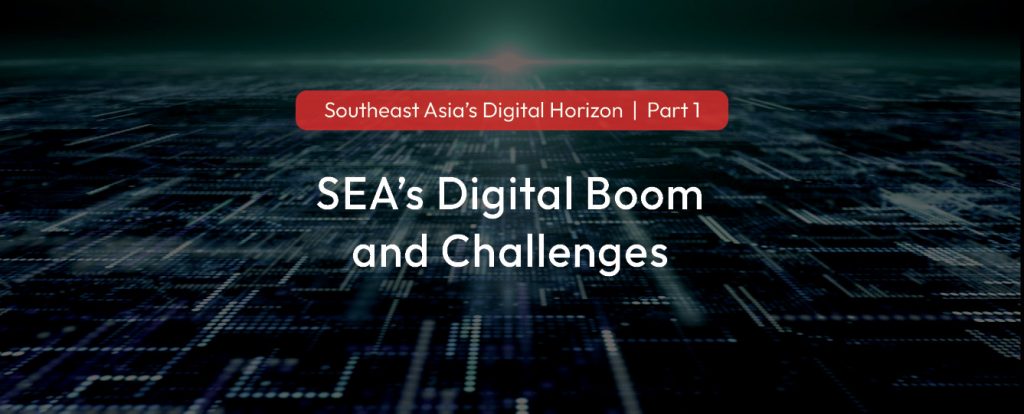Southeast Asia’s Digital Horizon. Part 1

Southeast Asia’s eCommerce is projected to grow by 100% over the next five years, according to a recent IDC Infobrief. This first entry in our 3-part blog series aims to provide business and IT network leaders with a good understanding of this evolving landscape. We’ll discuss the challenges and opportunities accompanying SEA’s digital boom, setting the stage for in-depth discussions on Federated CDNs and our SwiftFederation strategy.
Why This Matters to Business and Network Leaders
For businesses already operating in SEA or those looking to enter the market, understanding the digital landscape is crucial for strategic planning, risk mitigation, and capitalising on new opportunities. This is especially relevant for sectors like OTT streaming, eCommerce, digital publishers, and online gaming.
The Digital Landscape in Southeast Asia: A Snapshot
Today, Southeast Asia is more than just a cluster of countries; it’s a burgeoning digital powerhouse with over 500 million internet users, a testament to the region’s rapid digital adoption and growth. This user base is not just large but also increasingly connected, with an internet penetration rate of 76%, surpassing the global average of 64%, according to Digital 2023 report by We Are Socials and Meltwater. These figures underscore a region in the midst of a profound digital transformation, propelled by initiatives like the ASEAN Smart Cities Network, which aims to usher in a new era of smarter, more sustainable urban development across the region.
“ASEAN is on track to emerge as
a global centre of growth“
– World Economic Forum
The digital economy of Southeast Asia is a dynamic and fast-growing sector. Valued at $200 billion in 2022, it’s on track to expand to an impressive $1 trillion by 2030, as detailed in the e-Conomy SEA Report. This remarkable growth isn’t limited to general digital services; IDC’s recent report anticipates SEA’s eCommerce market size to grow by 100% over the next five years, eclipsing growth rates in other significant markets such as Korea, Japan, China, the US, and the EU. This surge signifies not only the region’s increasing digital consumption but also its rising prominence on the world stage as a major player in the global digital economy.
Challenges in a Fragmented Landscape
- Varying Internet Infrastructures: The digital divide in SEA is a complex issue that varies not only from one country to another but also within individual countries. While Tier 1 cities like Jakarta, Manila and Kuala Lumpur boast state-of-the-art connectivity, many rural areas and even some Tier 3 cities lag behind.
Over 200 million (41%) internet users live in the region’s less connected Tier 3 cities. While these areas show a high adoption rate of 74% in e-commerce, engagement in other digital services lags, indicating a broader gap in digital experience. - Multi-Supplier Complexities: Managing multiple suppliers for different services can further complicate this landscape. Businesses may have to navigate different sets of SLAs, on-site support availability, and even varying levels of service quality. For example, while a Tier 1 city might offer 24/7 support, a rural area may only have limited support hours, creating a logistical nightmare for businesses that require round-the-clock operations.
- Regulatory Framework: Each country in SEA has its unique set of digital laws and standards, making it challenging for businesses to maintain a uniform digital strategy. For instance, data localisation laws in Vietnam require businesses to store data within the country, while Singapore’s open data policy allows for more flexibility. Navigating these varying regulations requires a deep understanding of local laws and can often necessitate localised strategies.
- High Expectations for Quality Digital Experience: Consumers in SEA have high expectations when it comes to digital experiences. Speed, reliability, and security are non-negotiable. For instance, studies have shown that eCommerce conversion rates drop by 7% for every 100ms delay in load time. This puts immense pressure on businesses to optimise their digital platforms for performance, often requiring significant investments in CDN services and other optimisation technologies.
- Security Concerns: As digital economies contribute more to SEA’s GDP, the stakes in a cyber breach or downtime increase. While the security challenges are not unique to SEA, the region’s growing reliance on digitalisation makes it a significant area for organisations to address. For example, the increasing number of IoT devices in use across the region creates new vulnerabilities that businesses must be prepared to manage.
Uncover more insights and strategies tailored for the region here.
In unpacking the layered digital landscape of Southeast Asia, we’ve traversed through its vibrant opportunities and intricate challenges. The journey ahead for businesses is clear — adapt, innovate, and engage with the region’s digital evolution. As network leaders, the imperative is to not just witness but actively participate in shaping the digital future of Southeast Asia. Whether it’s improving infrastructure in Tier 3 cities, navigating multi-supplier complexities, or enhancing digital security measures, every step forward is a step towards tapping into the 100% growth opportunity that Southeast Asia offers.
We invite you to continue this journey with us. In the next instalment, we’ll explore how Federated CDNs, particularly our SwiftFederation, offer a strategic advantage in this dynamic landscape. Join us as we further dissect the technologies and strategies that can help your business thrive in the heart of Southeast Asia’s digital boom.



